

Compact Muon Solenoid
LHC, CERN
| CMS-EXO-23-013 ; CERN-EP-2024-225 | ||
| Search for light long-lived particles decaying to displaced jets in proton-proton collisions at $ \sqrt{s} = $ 13.6 TeV | ||
| CMS Collaboration | ||
| 17 September 2024 | ||
| Rep. Prog. Phys. 88 (2025) 037801 | ||
| Abstract: A search for light long-lived particles decaying to displaced jets is presented, using a data sample of proton-proton collisions at a center-of-mass energy of 13.6 TeV, corresponding to an integrated luminosity of 34.7 fb$ ^{-1} $, collected with the CMS detector at the CERN LHC in 2022. Novel trigger, reconstruction, and machine-learning techniques were developed for and employed in this search. After all selections, the observations are consistent with the background predictions. Limits are presented on the branching fraction of the Higgs boson to long-lived particles that subsequently decay to quark pairs or tau lepton pairs. An improvement by up to a factor of 10 is achieved over previous limits for models with long-lived particle masses smaller than 60 GeV and proper decay lengths smaller than 1 m. The first constraints are placed on the fraternal twin Higgs and folded supersymmetry models, where the lower bounds on the top quark partner mass reach up to 350 GeV for the fraternal twin Higgs model and 250 GeV for the folded supersymmetry model. | ||
| Links: e-print arXiv:2409.10806 [hep-ex] (PDF) ; CDS record ; inSPIRE record ; HepData record ; Physics Briefing ; CADI line (restricted) ; | ||
| Figures & Tables | Summary | Additional Figures | References | CMS Publications |
|---|
| Figures | |

png pdf |
Figure 1:
The Feynman diagram for the benchmark signal model, in which the SM-like Higgs boson with a mass of 125 GeV decays to two long-lived neutral scalars $ \text{S} $, and each of them decays to a pair of SM fermions. |

png pdf |
Figure 2:
The architectures of the displaced (left) and prompt-veto (right) taggers. The displaced tagger takes as input the dijet global features, displaced tracks, and DVs. The prompt-veto tagger takes as input the tracks with $ d_{xy} < $ 0.3 mm. |

png pdf |
Figure 2-a:
The architectures of the displaced (left) and prompt-veto (right) taggers. The displaced tagger takes as input the dijet global features, displaced tracks, and DVs. The prompt-veto tagger takes as input the tracks with $ d_{xy} < $ 0.3 mm. |
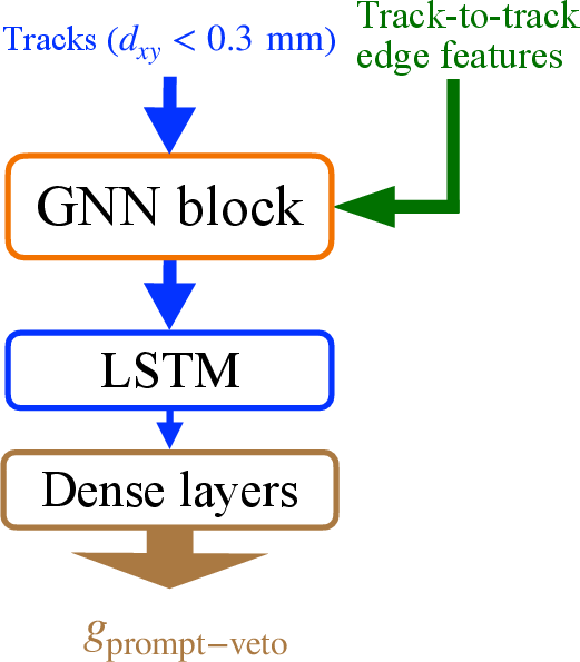
png pdf |
Figure 2-b:
The architectures of the displaced (left) and prompt-veto (right) taggers. The displaced tagger takes as input the dijet global features, displaced tracks, and DVs. The prompt-veto tagger takes as input the tracks with $ d_{xy} < $ 0.3 mm. |
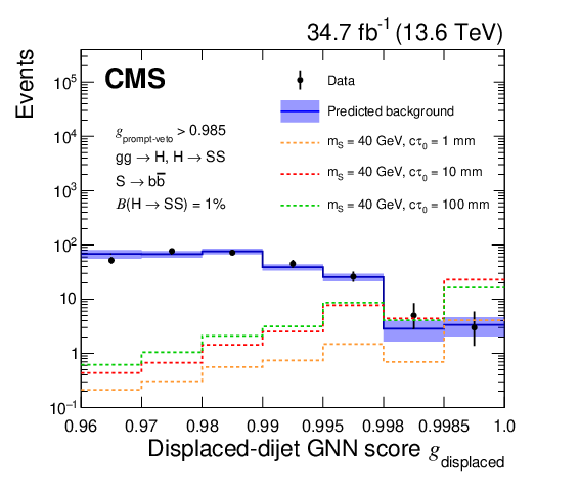
png pdf |
Figure 3:
The predicted background yields and the number of observed events for the data with $ g_{\text{prompt-veto}} > $ 0.985, shown for different bins of the displaced-dijet GNN score $ g_{\text{displaced}} $. Expected signal yields for the $ \mathrm{H}\to\text{S}\text{S} $, $ \text{S}\to\mathrm{b}\overline{\mathrm{b}} $ signature are also shown for models with $ m_{\text{S}}= $ 40 GeV and $ c\tau_{0}= $ 1, 10, or 100 mm, assuming a branching fraction of 1% for the $ \mathrm{H}\to\text{S}\text{S} $ decay. |

png pdf |
Figure 4:
The 95% CL upper limits on the branching fraction $ \mathcal{B}(\mathrm{H}\to\text{S}\text{S}) $ for $ \text{S}\to\mathrm{b}\overline{\mathrm{b}} $ (upper left), $ \text{S}\to\mathrm{d}\overline{\mathrm{d}} $ (upper right), and $ \text{S}\to\tau\tau $ (lower), for different LLP masses $ m_{\text{S}} $ and proper decay lengths $ c\tau_{0} $. The solid (dashed) lines represent the observed (median expected) limits. |
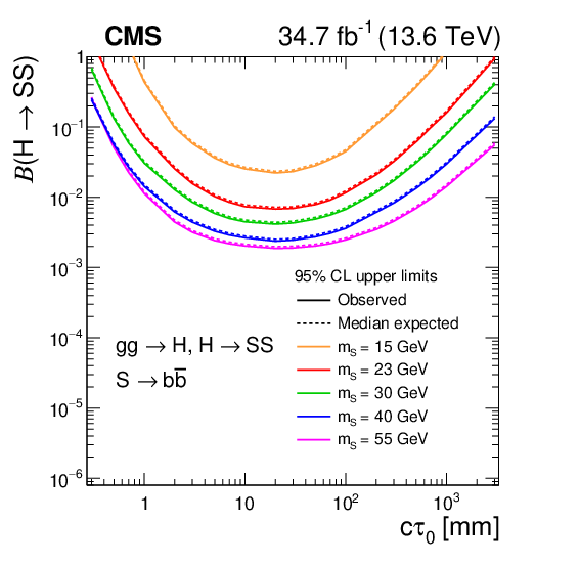
png pdf |
Figure 4-a:
The 95% CL upper limits on the branching fraction $ \mathcal{B}(\mathrm{H}\to\text{S}\text{S}) $ for $ \text{S}\to\mathrm{b}\overline{\mathrm{b}} $ (upper left), $ \text{S}\to\mathrm{d}\overline{\mathrm{d}} $ (upper right), and $ \text{S}\to\tau\tau $ (lower), for different LLP masses $ m_{\text{S}} $ and proper decay lengths $ c\tau_{0} $. The solid (dashed) lines represent the observed (median expected) limits. |
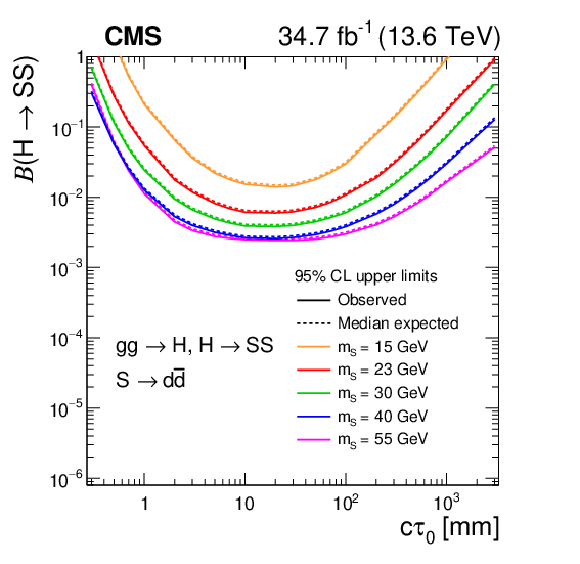
png pdf |
Figure 4-b:
The 95% CL upper limits on the branching fraction $ \mathcal{B}(\mathrm{H}\to\text{S}\text{S}) $ for $ \text{S}\to\mathrm{b}\overline{\mathrm{b}} $ (upper left), $ \text{S}\to\mathrm{d}\overline{\mathrm{d}} $ (upper right), and $ \text{S}\to\tau\tau $ (lower), for different LLP masses $ m_{\text{S}} $ and proper decay lengths $ c\tau_{0} $. The solid (dashed) lines represent the observed (median expected) limits. |
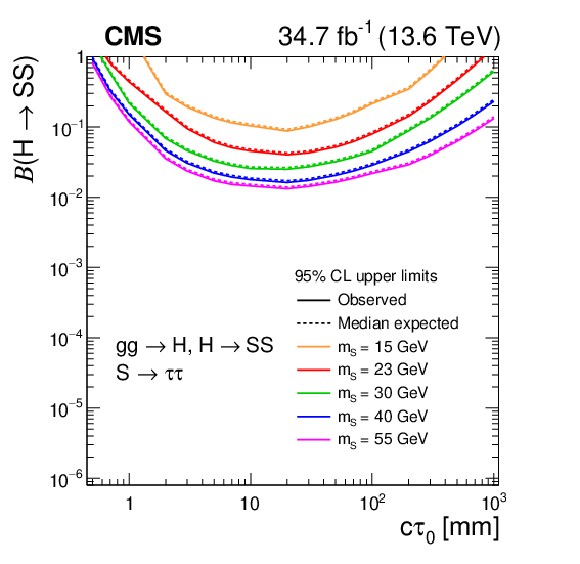
png pdf |
Figure 4-c:
The 95% CL upper limits on the branching fraction $ \mathcal{B}(\mathrm{H}\to\text{S}\text{S}) $ for $ \text{S}\to\mathrm{b}\overline{\mathrm{b}} $ (upper left), $ \text{S}\to\mathrm{d}\overline{\mathrm{d}} $ (upper right), and $ \text{S}\to\tau\tau $ (lower), for different LLP masses $ m_{\text{S}} $ and proper decay lengths $ c\tau_{0} $. The solid (dashed) lines represent the observed (median expected) limits. |
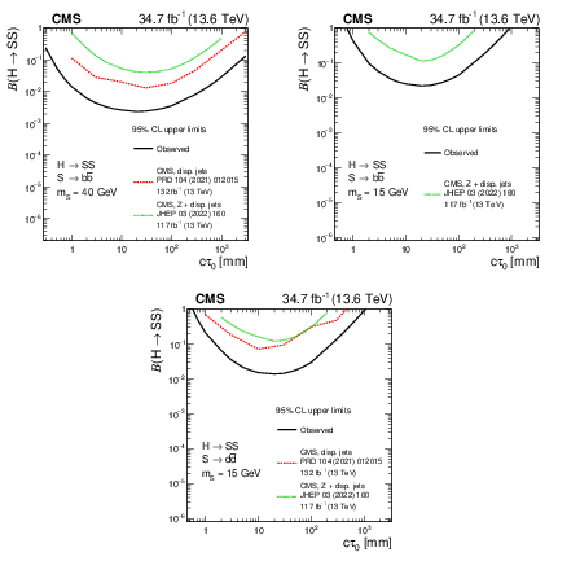
png pdf |
Figure 5:
Comparisons of the observed limits from this search and other results, for $ \text{S}\to\mathrm{b}\overline{\mathrm{b}} $, $ m_{\text{S}}= $ 40 GeV (upper left); $ \text{S}\to\mathrm{b}\overline{\mathrm{b}} $, $ m_{\text{S}}= $ 15 GeV (upper right); and $ \text{S}\to\mathrm{d}\overline{\mathrm{d}} $, $ m_{\text{S}}= $ 15 GeV (lower). The other results include the previous CMS displaced-jets search [44] (red dashed lines) and the CMS Z + displaced-jets search [45] (green dotted lines), where the observed limits agree with the median expected limits within 15% and are within the regions containing 68% of the distributions of the limits expected under the background-only hypothesis. |
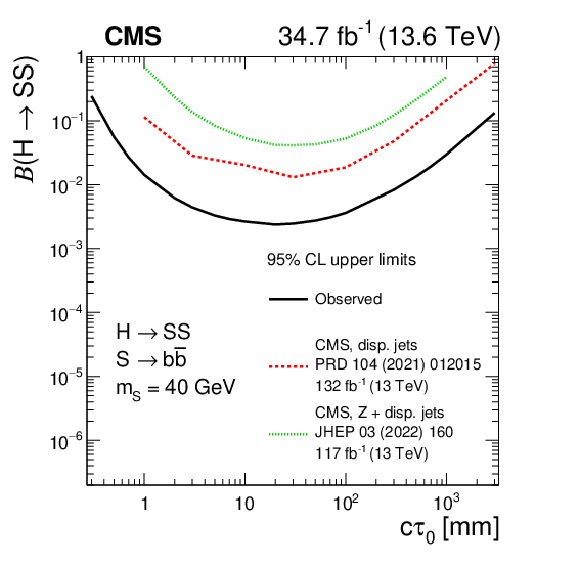
png pdf |
Figure 5-a:
Comparisons of the observed limits from this search and other results, for $ \text{S}\to\mathrm{b}\overline{\mathrm{b}} $, $ m_{\text{S}}= $ 40 GeV (upper left); $ \text{S}\to\mathrm{b}\overline{\mathrm{b}} $, $ m_{\text{S}}= $ 15 GeV (upper right); and $ \text{S}\to\mathrm{d}\overline{\mathrm{d}} $, $ m_{\text{S}}= $ 15 GeV (lower). The other results include the previous CMS displaced-jets search [44] (red dashed lines) and the CMS Z + displaced-jets search [45] (green dotted lines), where the observed limits agree with the median expected limits within 15% and are within the regions containing 68% of the distributions of the limits expected under the background-only hypothesis. |
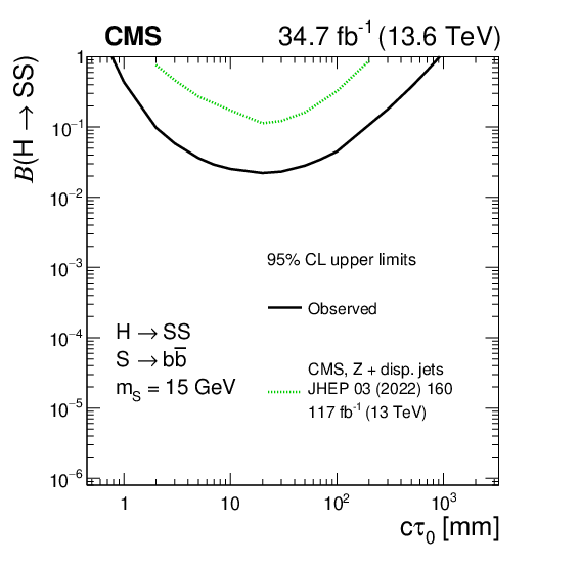
png pdf |
Figure 5-b:
Comparisons of the observed limits from this search and other results, for $ \text{S}\to\mathrm{b}\overline{\mathrm{b}} $, $ m_{\text{S}}= $ 40 GeV (upper left); $ \text{S}\to\mathrm{b}\overline{\mathrm{b}} $, $ m_{\text{S}}= $ 15 GeV (upper right); and $ \text{S}\to\mathrm{d}\overline{\mathrm{d}} $, $ m_{\text{S}}= $ 15 GeV (lower). The other results include the previous CMS displaced-jets search [44] (red dashed lines) and the CMS Z + displaced-jets search [45] (green dotted lines), where the observed limits agree with the median expected limits within 15% and are within the regions containing 68% of the distributions of the limits expected under the background-only hypothesis. |
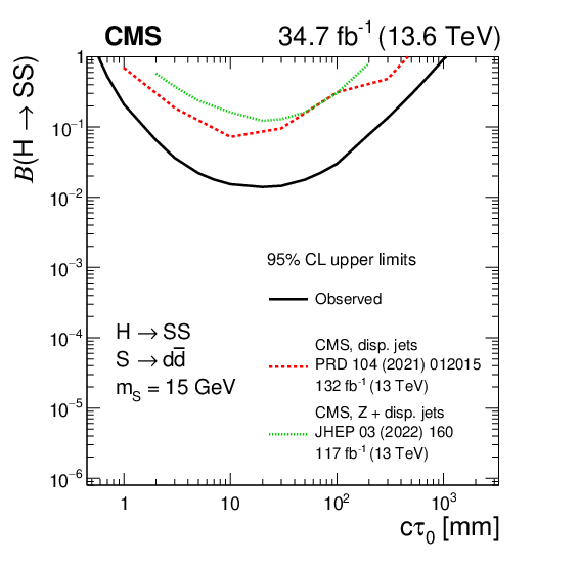
png pdf |
Figure 5-c:
Comparisons of the observed limits from this search and other results, for $ \text{S}\to\mathrm{b}\overline{\mathrm{b}} $, $ m_{\text{S}}= $ 40 GeV (upper left); $ \text{S}\to\mathrm{b}\overline{\mathrm{b}} $, $ m_{\text{S}}= $ 15 GeV (upper right); and $ \text{S}\to\mathrm{d}\overline{\mathrm{d}} $, $ m_{\text{S}}= $ 15 GeV (lower). The other results include the previous CMS displaced-jets search [44] (red dashed lines) and the CMS Z + displaced-jets search [45] (green dotted lines), where the observed limits agree with the median expected limits within 15% and are within the regions containing 68% of the distributions of the limits expected under the background-only hypothesis. |
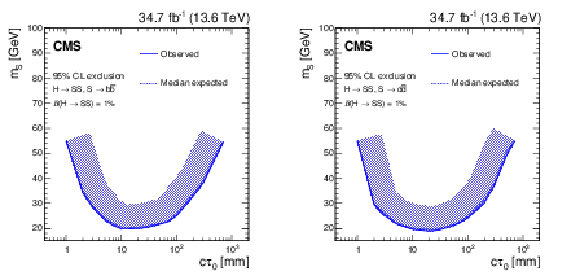
png pdf |
Figure 6:
The 95% CL limits on the LLP mass $ m_{\text{S}} $ for different proper decay lengths $ c\tau_{0} $ assuming a branching fraction of 1% for the $ \mathrm{H}\to\text{S}\text{S} $ decay, and with subsequent $ \text{S}\to\mathrm{b}\overline{\mathrm{b}} $ (left) or $ \text{S}\to\mathrm{d}\overline{\mathrm{d}} $ (right) decays. The solid (dashed) lines represent the observed (median expected) limits. The hashed areas indicate the direction of the excluded area from the observed limits. |

png pdf |
Figure 6-a:
The 95% CL limits on the LLP mass $ m_{\text{S}} $ for different proper decay lengths $ c\tau_{0} $ assuming a branching fraction of 1% for the $ \mathrm{H}\to\text{S}\text{S} $ decay, and with subsequent $ \text{S}\to\mathrm{b}\overline{\mathrm{b}} $ (left) or $ \text{S}\to\mathrm{d}\overline{\mathrm{d}} $ (right) decays. The solid (dashed) lines represent the observed (median expected) limits. The hashed areas indicate the direction of the excluded area from the observed limits. |
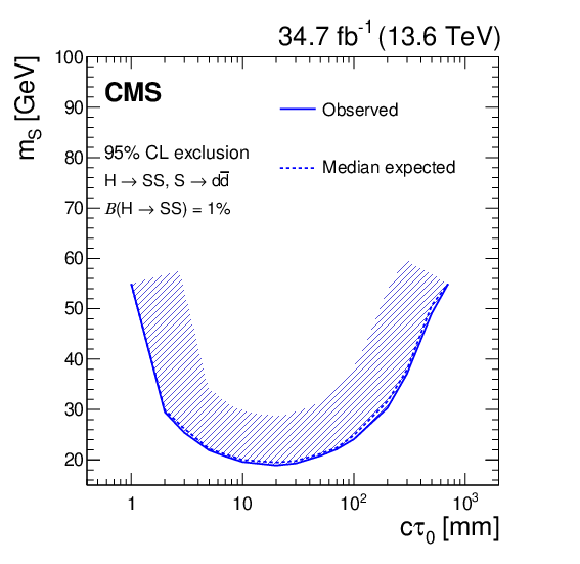
png pdf |
Figure 6-b:
The 95% CL limits on the LLP mass $ m_{\text{S}} $ for different proper decay lengths $ c\tau_{0} $ assuming a branching fraction of 1% for the $ \mathrm{H}\to\text{S}\text{S} $ decay, and with subsequent $ \text{S}\to\mathrm{b}\overline{\mathrm{b}} $ (left) or $ \text{S}\to\mathrm{d}\overline{\mathrm{d}} $ (right) decays. The solid (dashed) lines represent the observed (median expected) limits. The hashed areas indicate the direction of the excluded area from the observed limits. |

png pdf |
Figure 7:
The 95% CL limits on the dark-sector top quark partner mass $ m_{{\mathrm{T}} } $ for different hidden glueball masses $ m_{0} $, in the fraternal twin Higgs model [29] (left) and the folded SUSY model [49] (right). The solid (dashed) lines represent the observed (median expected) limits. The hashed areas indicate the direction of the excluded area from the observed limits. |
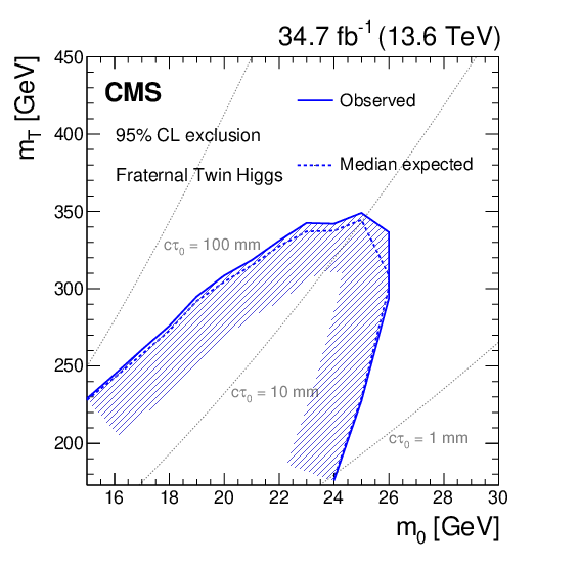
png pdf |
Figure 7-a:
The 95% CL limits on the dark-sector top quark partner mass $ m_{{\mathrm{T}} } $ for different hidden glueball masses $ m_{0} $, in the fraternal twin Higgs model [29] (left) and the folded SUSY model [49] (right). The solid (dashed) lines represent the observed (median expected) limits. The hashed areas indicate the direction of the excluded area from the observed limits. |
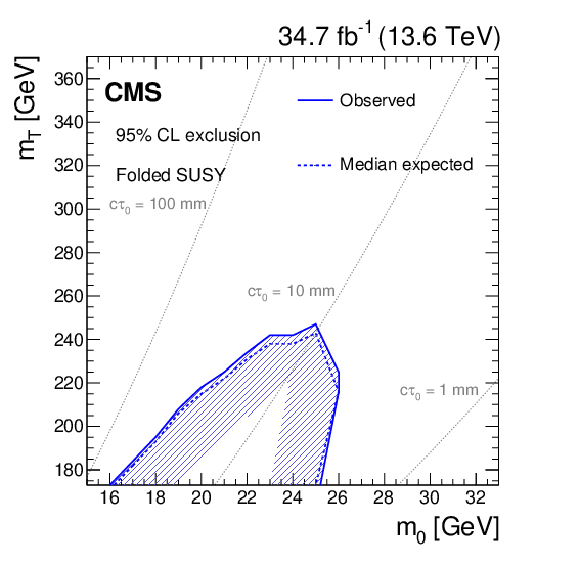
png pdf |
Figure 7-b:
The 95% CL limits on the dark-sector top quark partner mass $ m_{{\mathrm{T}} } $ for different hidden glueball masses $ m_{0} $, in the fraternal twin Higgs model [29] (left) and the folded SUSY model [49] (right). The solid (dashed) lines represent the observed (median expected) limits. The hashed areas indicate the direction of the excluded area from the observed limits. |
| Tables | |

png pdf |
Table 1:
The predicted background yields and observations in the region with $ g_{\text{prompt-veto}} > $ 0.985 for different $ g_{\text{displaced}} $ ranges. The background predictions are shown with their statistical uncertainties. The significance of any deviation between the observation and prediction for each $ g_{\text{displaced}} $ range is shown as a $ Z $-value. |

png pdf |
Table 2:
Summary of the systematic uncertainties in the signal yields. |

png pdf |
Table 3:
Signal efficiencies scaled by a factor of 10$^{4} $ for the $ \mathrm{H}\to\text{S}\text{S} $ signature with $ \text{S}\to\mathrm{b}\overline{\mathrm{b}} $, $ \text{S}\to\mathrm{d}\overline{\mathrm{d}} $, and $ \text{S}\to\tau\tau $ decays in the signal region D, shown for representative signal points with different $ m_{\text{S}} $ and $ c\tau_{0} $ values. Only statistical uncertainties are listed. |
| Summary |
| A search for light long-lived particles decaying into jets has been performed using proton-proton collision data corresponding to an integrated luminosity of 34.7 fb$ ^{-1} $, collected with the CMS experiment at a center-of-mass energy of 13.6 TeV in 2022. Novel techniques in trigger, reconstruction, and machine learning were developed for and employed in this search, leading to significant improvements over existing results. The observed yields are consistent with the background predictions. The best limits to date are set for long-lived particles with masses between 15 and 55 GeV and with proper decay lengths smaller than $ \approx $1 m. The search provides the first exclusions of hadronically decaying displaced tau leptons arising from LLPs with decay lengths smaller than $ \approx $1 m. For the signature where the Higgs boson decays to two long-lived particles that further decay to bottom (down) quark pairs, branching fractions greater than 1% for the exotic Higgs boson decay are excluded for a long-lived particle mass larger than 40 GeV and mean proper decay lengths between 1.5 (1.3) and 370 (380) mm. For these signatures, the branching fraction limits are better than those obtained previously by a factor of up to 10 (8). Exclusions are also placed on the parameter space of the fraternal twin Higgs and folded supersymmetry models in the neutral naturalness scenario, giving lower limits on top quark partner masses of up to 350 and 250 GeV, respectively. The results are the first constraints placed on these models. |
| Additional Figures | |
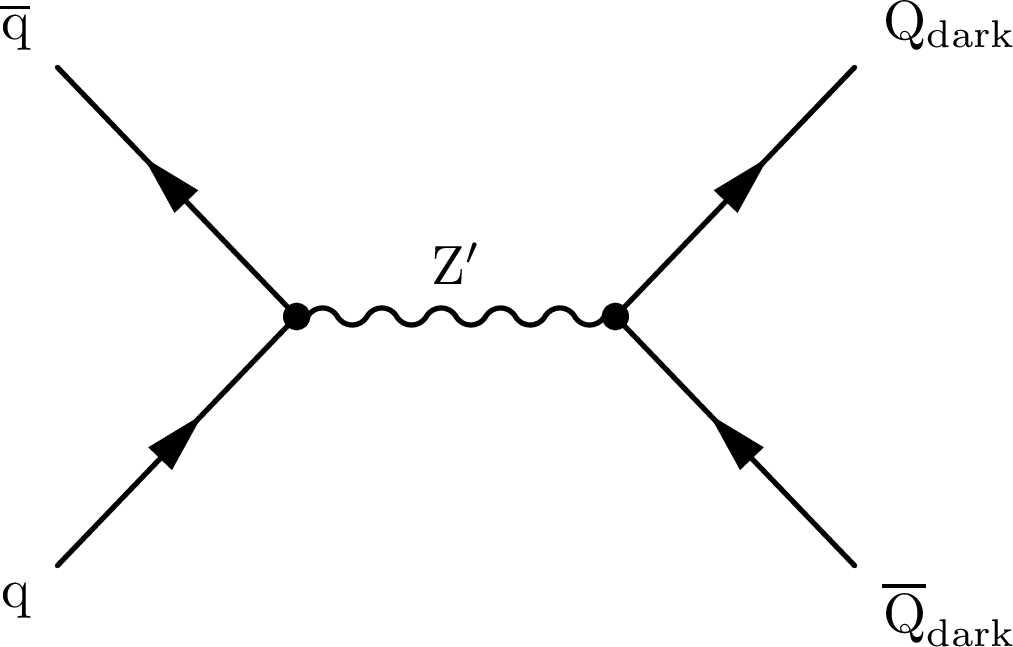
png pdf |
Additional Figure 1:
The Feynman diagram showing the production of dark quarks $ \text{Q}_{\text{dark}} $ through the decays of a $ \mathrm{Z}^{'} $ boson, which couples to the SM quarks and dark quarks. The dark quarks are SM singlets and are charged under a new confining gauge group in the dark sector. After production, they undergo parton shower and hadronization within the dark sector, producing long-lived dark hadrons than can subsequently decay into SM particles, leading to dark shower signatures. Such signatures can arise from Hidden Valley scenarios [18,19,20,107]. The parton showering and hadronization in both the dark sector and the SM sector are simulated using PYTHIA 8.306. The production and decay of the $ \mathrm{Z}^{'} $ boson are simulated with PYTHIA. Following the model proposed in Ref. [108], the dark sector is assumed to have $ N_{c} = 3,\ N_{f} = 7,\ m_{\text{Q}_{\text{dark}}}=\Lambda_{\text{dark}}=2 m_{\pi_{\text{dark}}} = 0.5m_{\rho_{\text{dark}}} $. $ N_{c} $ is the number of colors of the new dark confining gauge group, $ N_{f} $ is the number of flavors, $ \Lambda_{\text{dark}} $ is the confinement scale of the dark sector, $ \pi_{\text{dark}} $ is the spin-0 dark pion and is assumed to decay to a pair of SM down quarks $ \pi_{\text{dark}}\to\mathrm{d}\overline{\mathrm{d}} $, and $ \rho_{\text{dark}} $ is the spin-1 dark $ \rho $ meson which decays promptly to dark pions via $ \rho_{\text{dark}}\to\pi_{\text{dark}}\pi_{\text{dark}} $. |
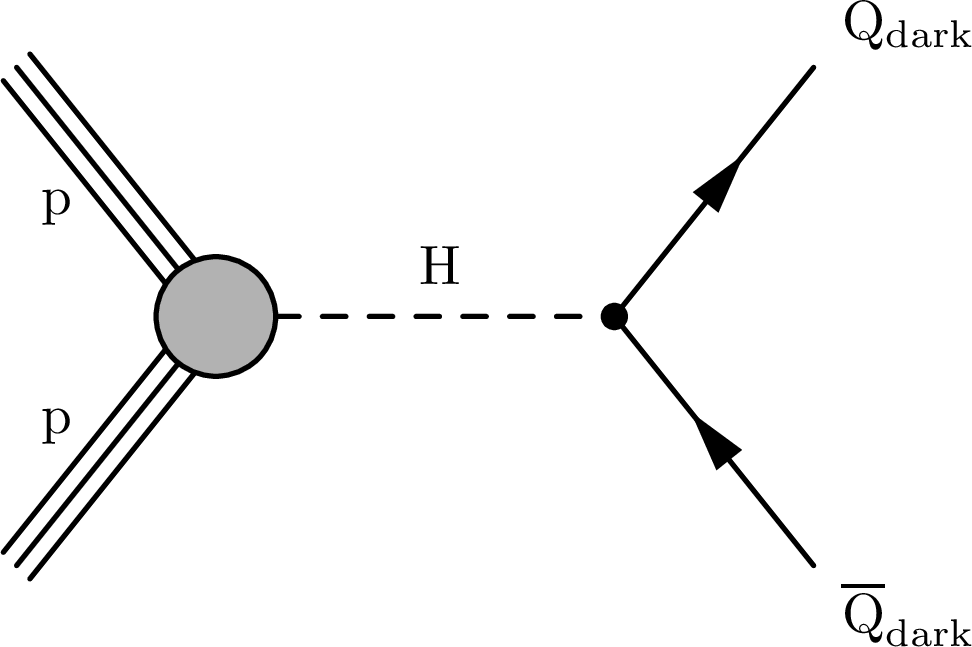
png pdf |
Additional Figure 2:
The Feynman diagram showing the production of dark quarks $ \text{Q}_{\text{dark}} $ through the decays of a 125GeV Higgs boson. The dark quarks are SM singlets and are charged under a new confining gauge group in the dark sector. After production, they undergo parton shower and hadronization within the dark sector, producing long-lived dark hadrons than can subsequently decay into SM particles, leading to dark shower signatures. Such signatures can arise from Hidden Valley scenarios [18,19,20,107]. The parton showering and hadronization in both the dark sector and the SM sector are simulated using PYTHIA 8.306. The POWHEG 2.0 program is used to generate events containing a 125 GeV Higgs boson via gluon-gluon fusion at the next-to-leading order. The $ \mathrm{H}\to\text{Q}_{\text{dark}}\overline{\text{Q}}_{\text{dark}} $ process is simulated using PYTHIA. The dark sector setting follows the benchmarks proposed in Ref. [109], where $ N_{c} = $ 3 and $ N_{f} = $ 1 are assumed. $ \Lambda_{\text{dark}} $, $ m_{\pi_{\text{dark}}} $, and $ m_{\rho_{\text{dark}}} $ are assumed to satisfy $ (\Lambda_{\text{dark}}/m_{\pi_{\text{dark}}},\ m_{\rho_{\text{dark}}}/m_{\pi_{\text{dark}}}) = (2.5,\ 2.5) $, $ (1,\ 2.5) $, or $ (1,\ 1) $. When $ m_{\rho_{\text{dark}}} > 2m_{\pi_{\text{dark}}} $, $ \rho_{\text{dark}} $ decays promptly via $ \rho_{\text{dark}}\to\pi_{\text{dark}}\pi_{\text{dark}} $; otherwise, $ \rho_{\text{dark}} $ is stable. $ \pi_{\text{dark}} $ is long lived and is assumed to decay to SM particles. For $ \pi_{\text{dark}} $ decays two scenarios are considered. In the first scenario, the $ \pi_{\text{dark}} $ decay is assumed to be mediated by an offshell Higgs boson ($ \pi_{\text{dark}}\to\mathrm{H}^{*}\to\mathrm{f}\overline{\mathrm{f}} $); the decay branching fractions are therefore determined by the Higgs boson couplings. In the second scenario, the branching fraction for $ \pi_{\text{dark}} $ to decay to a pair of gluons $ \mathcal{B}(\pi_{\text{dark}}\to\mathrm{g}\mathrm{g}) $ is assumed to be 100%. Additionally, the dark sector setting with $ N_{c} = 3,\ N_{f} = 7,\ m_{\text{Q}_{\text{dark}}}=\Lambda_{\text{dark}}=2 m_{\pi_{\text{dark}}} = 0.5m_{\rho_{\text{dark}}} $ is also considered for comparison, where a $ \mathcal{B}(\pi_{\text{dark}}\to\mathrm{d}\overline{\mathrm{d}}) $ of 100% is assumed. |
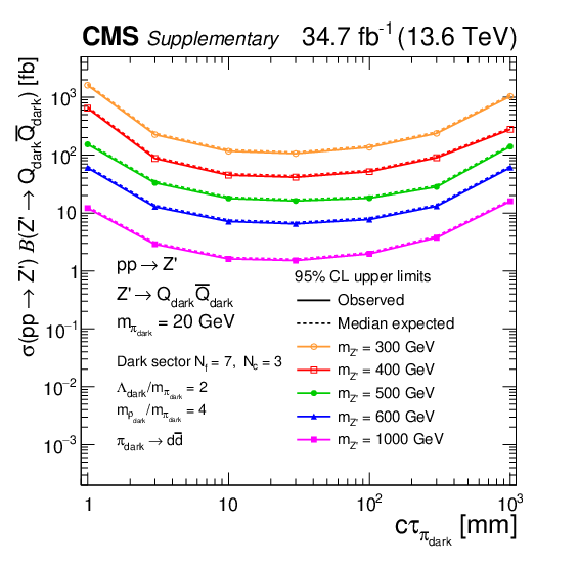
png pdf |
Additional Figure 3:
The 95% CL upper limits on $ \sigma\left(\mathrm{p}\mathrm{p}\to\mathrm{Z}^{'}\right)\mathcal{B}\left(\mathrm{Z}^{'}\to\text{Q}_{\text{dark}}\overline{\text{Q}}_{\text{dark}}\right) $ when the dark pion mass $ m_{\pi_{\text{dark}}} $ is 20 GeV, as a function of the dark pion lifetime $ c\tau_{\pi_{\text{dark}}} $ for different $ \mathrm{Z}^{'} $ boson masses $ m_{\mathrm{Z}^{'}} $. The dashed (solid) lines represent expected (observed) limits. For the dark sector parton showering and hadronization $ N_{f}= $ 7, $ N_{c}= $ 3, $ \Lambda_{\text{dark}}/m_{\pi_{\text{dark}}}= $ 2, $ m_{\rho_{\text{dark}}}/m_{\pi_{\text{dark}}}= $ 4 are assumed. |
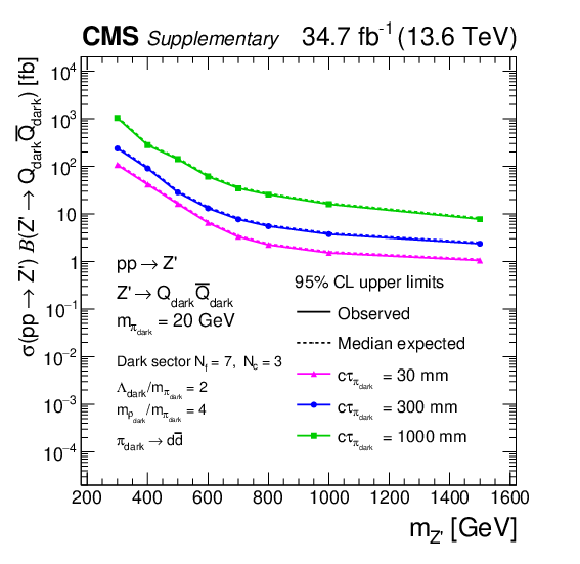
png pdf |
Additional Figure 4:
The 95% CL upper limits on $ \sigma\left(\mathrm{p}\mathrm{p}\to\mathrm{Z}^{'}\right)\mathcal{B}\left(\mathrm{Z}^{'}\to\text{Q}_{\text{dark}}\overline{\text{Q}}_{\text{dark}}\right) $ when the dark pion mass $ m_{\pi_{\text{dark}}} $ is 20 GeV, as a function of the $ \mathrm{Z}^{'} $ boson mass $ m_{\mathrm{Z}^{'}} $ for different dark pion lifetimes $ c\tau_{\pi_{\text{dark}}} $. The dashed (solid) lines represent expected (observed) limits. For the dark sector parton showering and hadronization $ N_{f}= $ 7, $ N_{c}= $ 3, $ \Lambda_{\text{dark}}/m_{\pi_{\text{dark}}}= $ 2, $ m_{\rho_{\text{dark}}}/m_{\pi_{\text{dark}}}= $ 4 are assumed. |
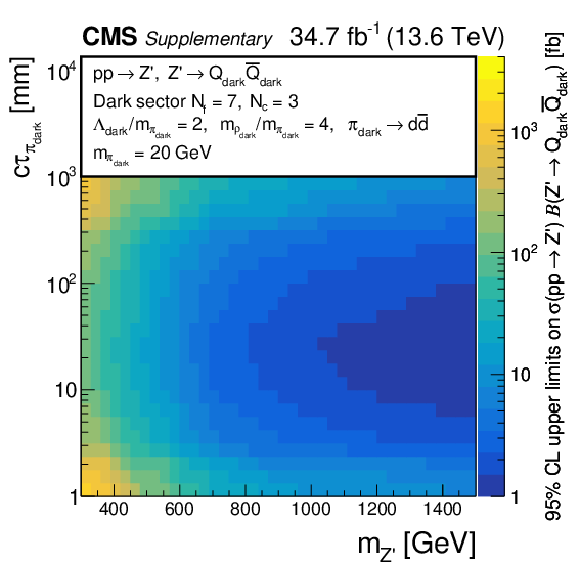
png pdf |
Additional Figure 5:
The 95% CL observed upper limits on $ \sigma\left(\mathrm{p}\mathrm{p}\to\mathrm{Z}^{'}\right)\mathcal{B}\left(\mathrm{Z}^{'}\to\text{Q}_{\text{dark}}\overline{\text{Q}}_{\text{dark}}\right) $ in the $ m_{\mathrm{Z}^{'}}-c\tau_{\pi_{\text{dark}}} $ plane when the dark pion mass $ m_{\pi_{\text{dark}}} $ is 20 GeV. For the dark sector parton showering and hadronization $ N_{f}= $ 7, $ N_{c}= $ 3, $ \Lambda_{\text{dark}}/m_{\pi_{\text{dark}}}= $ 2, $ m_{\rho_{\text{dark}}}/m_{\pi_{\text{dark}}}= $ 4 are assumed. |
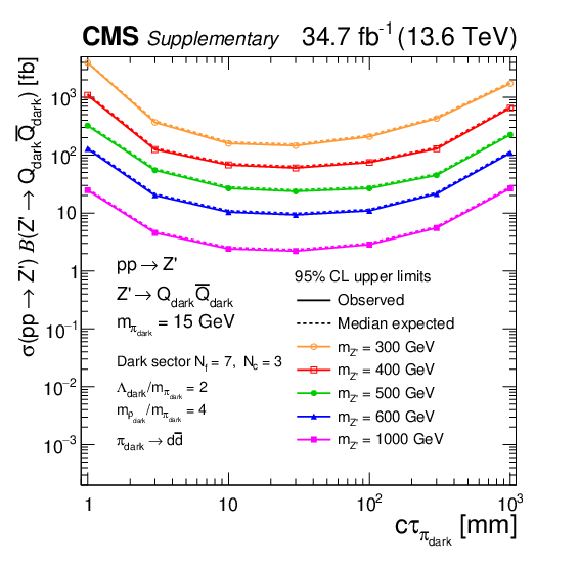
png pdf |
Additional Figure 6:
The 95% CL upper limits on $ \sigma\left(\mathrm{p}\mathrm{p}\to\mathrm{Z}^{'}\right)\mathcal{B}\left(\mathrm{Z}^{'}\to\text{Q}_{\text{dark}}\overline{\text{Q}}_{\text{dark}}\right) $ when the dark pion mass $ m_{\pi_{\text{dark}}} $ is 15 GeV, as a function of the dark pion lifetime $ c\tau_{\pi_{\text{dark}}} $ for different $ \mathrm{Z}^{'} $ masses $ m_{\mathrm{Z}^{'}} $. The dashed (solid) lines represent expected (observed) limits. For the dark sector parton showering and hadronization $ N_{f}= $ 7, $ N_{c}= $ 3, $ \Lambda_{\text{dark}}/m_{\pi_{\text{dark}}}= $ 2, $ m_{\rho_{\text{dark}}}/m_{\pi_{\text{dark}}}= $ 4 are assumed. |
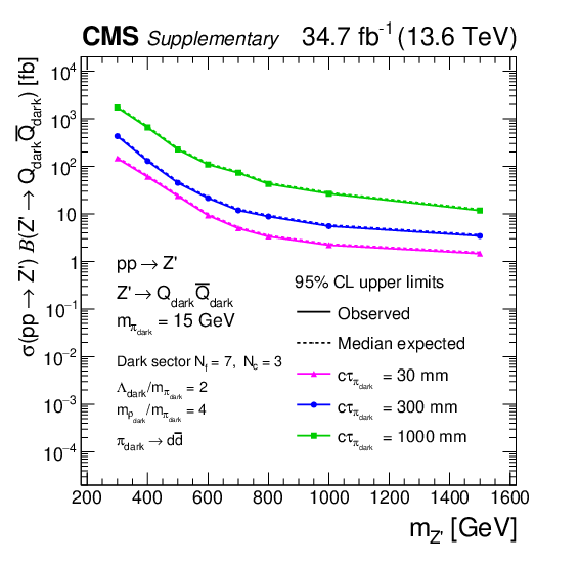
png pdf |
Additional Figure 7:
The 95% CL upper limits on $ \sigma\left(\mathrm{p}\mathrm{p}\to\mathrm{Z}^{'}\right)\mathcal{B}\left(\mathrm{Z}^{'}\to\text{Q}_{\text{dark}}\overline{\text{Q}}_{\text{dark}}\right) $ when the dark pion mass $ m_{\pi_{\text{dark}}} $ is 15 GeV, as a function of the $ \mathrm{Z}^{'} $ mass $ m_{\mathrm{Z}^{'}} $ for different dark pion lifetimes $ c\tau_{\pi_{\text{dark}}} $. The dashed (solid) lines represent expected (observed) limits. For the dark sector parton showering and hadronization $ N_{f}= $ 7, $ N_{c}= $ 3, $ \Lambda_{\text{dark}}/m_{\pi_{\text{dark}}}= $ 2, $ m_{\rho_{\text{dark}}}/m_{\pi_{\text{dark}}}= $ 4 are assumed. |
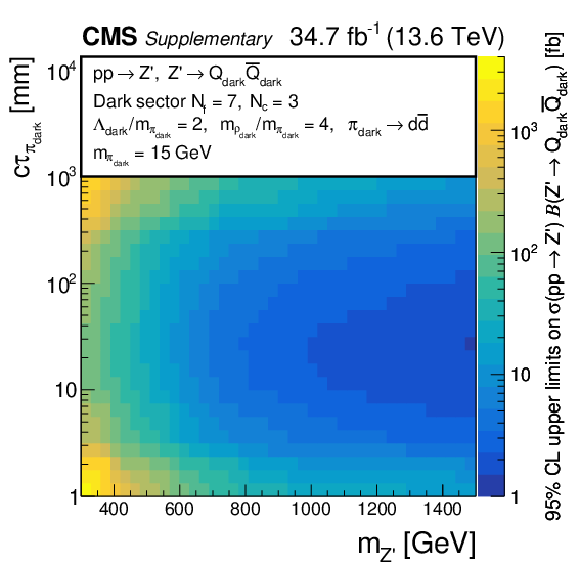
png pdf |
Additional Figure 8:
The 95% CL observed upper limits on $ \sigma\left(\mathrm{p}\mathrm{p}\to\mathrm{Z}^{'}\right)\mathcal{B}\left(\mathrm{Z}^{'}\to\text{Q}_{\text{dark}}\overline{\text{Q}}_{\text{dark}}\right) $ when the dark pion mass $ m_{\pi_{\text{dark}}} $ is 15 GeV in the $ m_{\mathrm{Z}^{'}}-c\tau_{\pi_{\text{dark}}} $ plane. For the dark sector parton showering and hadronization $ N_{f}= $ 7, $ N_{c}= $ 3, $ \Lambda_{\text{dark}}/m_{\pi_{\text{dark}}}= $ 2, $ m_{\rho_{\text{dark}}}/m_{\pi_{\text{dark}}}= $ 4 are assumed. |
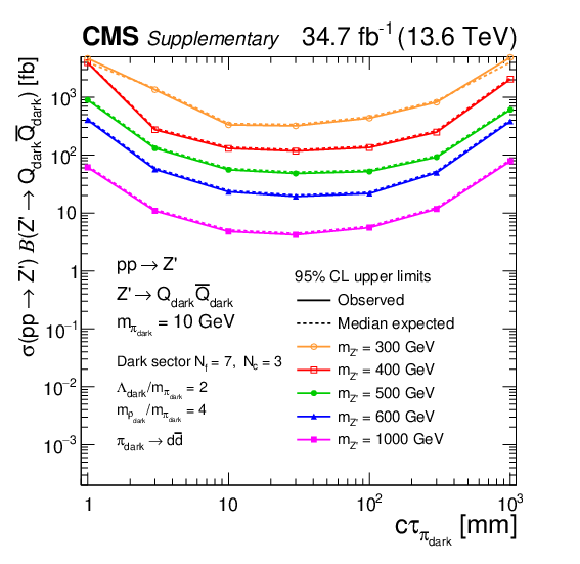
png pdf |
Additional Figure 9:
The 95% CL upper limits on $ \sigma\left(\mathrm{p}\mathrm{p}\to\mathrm{Z}^{'}\right)\mathcal{B}\left(\mathrm{Z}^{'}\to\text{Q}_{\text{dark}}\overline{\text{Q}}_{\text{dark}}\right) $ when the dark pion mass $ m_{\pi_{\text{dark}}} $ is 10 GeV, as a function of the dark pion lifetime $ c\tau_{\pi_{\text{dark}}} $ for different $ \mathrm{Z}^{'} $ boson masses $ m_{\mathrm{Z}^{'}} $. The dashed (solid) lines represent expected (observed) limits. For the dark sector parton showering and hadronization $ N_{f}= $ 7, $ N_{c}= $ 3, $ \Lambda_{\text{dark}}/m_{\pi_{\text{dark}}}= $ 2, $ m_{\rho_{\text{dark}}}/m_{\pi_{\text{dark}}}= $ 4 are assumed. |
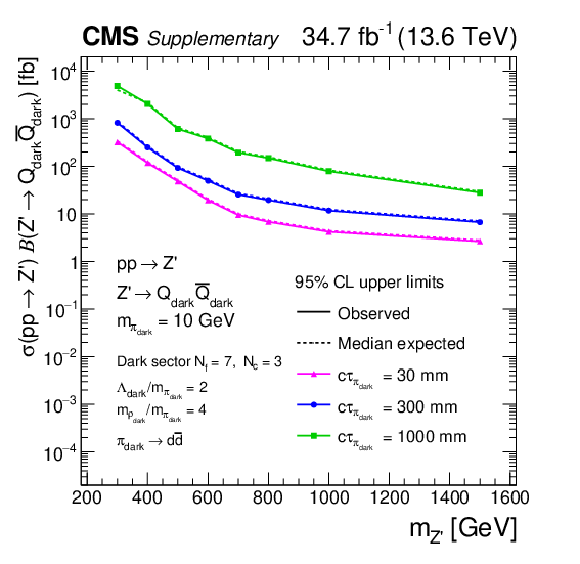
png pdf |
Additional Figure 10:
The 95% CL upper limits on $ \sigma\left(\mathrm{p}\mathrm{p}\to\mathrm{Z}^{'}\right)\mathcal{B}\left(\mathrm{Z}^{'}\to\text{Q}_{\text{dark}}\overline{\text{Q}}_{\text{dark}}\right) $ when the dark pion mass $ m_{\pi_{\text{dark}}} $ is 10 GeV, as a function of the $ \mathrm{Z}^{'} $ boson mass $ m_{\mathrm{Z}^{'}} $ for different dark pion lifetimes $ c\tau_{\pi_{\text{dark}}} $. The dashed (solid) lines represent expected (observed) limits. For the dark sector parton showering and hadronization $ N_{f}= $ 7, $ N_{c}= $ 3, $ \Lambda_{\text{dark}}/m_{\pi_{\text{dark}}}= $ 2, $ m_{\rho_{\text{dark}}}/m_{\pi_{\text{dark}}}= $ 4 are assumed. |
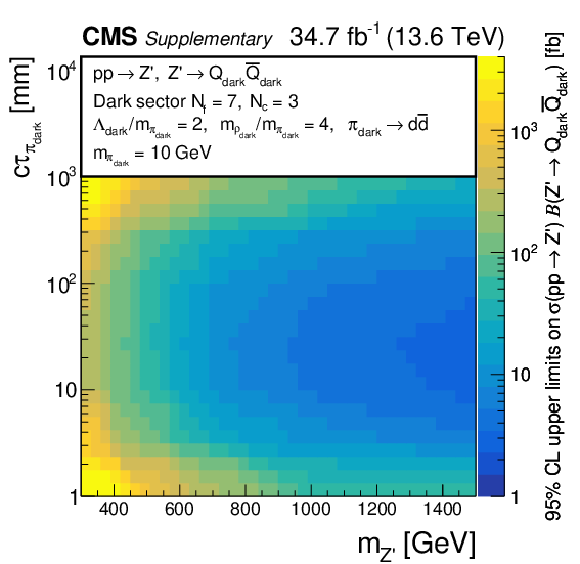
png pdf |
Additional Figure 11:
The 95% CL observed upper limits on $ \sigma\left(\mathrm{p}\mathrm{p}\to\mathrm{Z}^{'}\right)\mathcal{B}\left(\mathrm{Z}^{'}\to\text{Q}_{\text{dark}}\overline{\text{Q}}_{\text{dark}}\right) $ when the dark pion mass $ m_{\pi_{\text{dark}}} $ is 10 GeV in the $ m_{\mathrm{Z}^{'}}-c\tau_{\pi_{\text{dark}}} $ plane. For the dark sector parton showering and hadronization $ N_{f}= $ 7, $ N_{c}= $ 3, $ \Lambda_{\text{dark}}/m_{\pi_{\text{dark}}}= $ 2, $ m_{\rho_{\text{dark}}}/m_{\pi_{\text{dark}}}= $ 4 are assumed. |
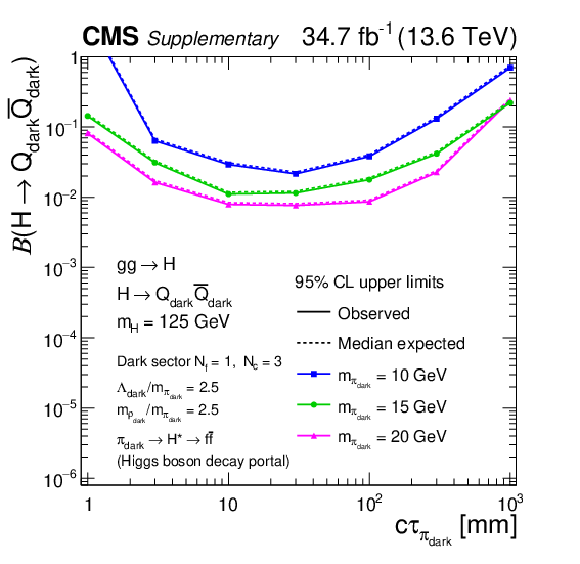
png pdf |
Additional Figure 12:
The 95% CL upper limits on the branching fraction for the 125 GeV Higgs boson to decay to a pair of dark quarks $ \mathcal{B}(\mathrm{H}\to\text{Q}_{\text{dark}}\overline{\text{Q}}_{\text{dark}}) $ when the dark sector $ N_{f}= $ 1, $ N_{c}= $ 3. The dark pion $ \pi_{\text{dark}} $ is assumed to decay to SM particles through an offshell Higgs boson. The upper limits are shown for different dark pion masses $ m_{\pi_{\text{dark}}} $ and proper decay lengths $ c\tau_{\pi_{\text{dark}}} $, with $ m_{\rho_{\text{dark}}}/m_{\pi_{\text{dark}}}= $ 2.5, $ \Lambda_{\text{dark}}/m_{\pi_{\text{dark}}}= $ 2.5. The dashed (solid) lines represent the expected (observed) upper limits. |
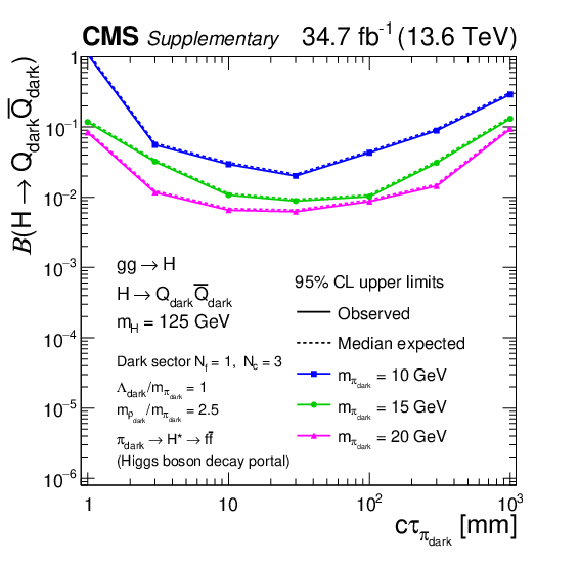
png pdf |
Additional Figure 13:
The 95% CL upper limits on the branching fraction for the 125 GeV Higgs boson to decay to a pair of dark quarks $ \mathcal{B}(\mathrm{H}\to\text{Q}_{\text{dark}}\overline{\text{Q}}_{\text{dark}}) $ when the dark sector $ N_{f}= $ 1, $ N_{c}= $ 3. The dark pion $ \pi_{\text{dark}} $ is assumed to decay to SM particles through an offshell Higgs boson. The upper limits are shown for different dark pion masses $ m_{\pi_{\text{dark}}} $ and proper decay lengths $ c\tau_{\pi_{\text{dark}}} $, with $ m_{\rho_{\text{dark}}}/m_{\pi_{\text{dark}}}= $ 2.5, $ \Lambda_{\text{dark}}/m_{\pi_{\text{dark}}}= $ 1. The dashed (solid) lines represent the expected (observed) upper limits. |
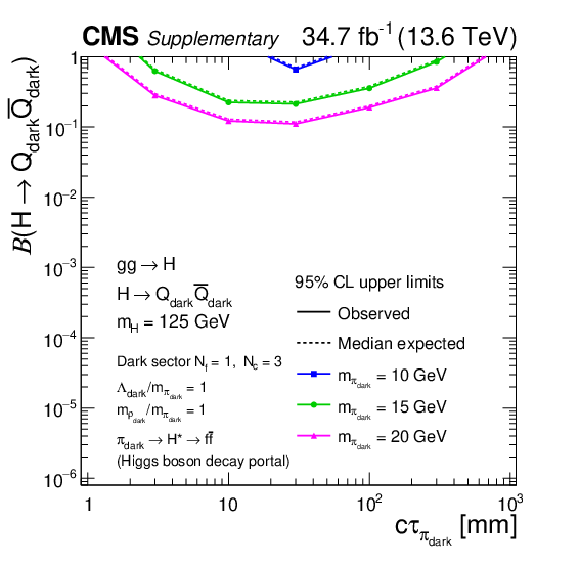
png pdf |
Additional Figure 14:
The 95% CL upper limits on the branching fraction for the 125 GeV Higgs boson to decay to a pair of dark quarks $ \mathcal{B}(\mathrm{H}\to\text{Q}_{\text{dark}}\overline{\text{Q}}_{\text{dark}}) $ when the dark sector $ N_{f}= $ 1, $ N_{c}= $ 3. The dark pion $ \pi_{\text{dark}} $ is assumed to decay to SM particles through an offshell Higgs boson. The upper limits are shown for different dark pion masses $ m_{\pi_{\text{dark}}} $ and proper decay lengths $ c\tau_{\pi_{\text{dark}}} $, with $ m_{\rho_{\text{dark}}}/m_{\pi_{\text{dark}}}= $ 1, $ \Lambda_{\text{dark}}/m_{\pi_{\text{dark}}}= $ 1. The dashed (solid) lines represent the expected (observed) upper limits. |
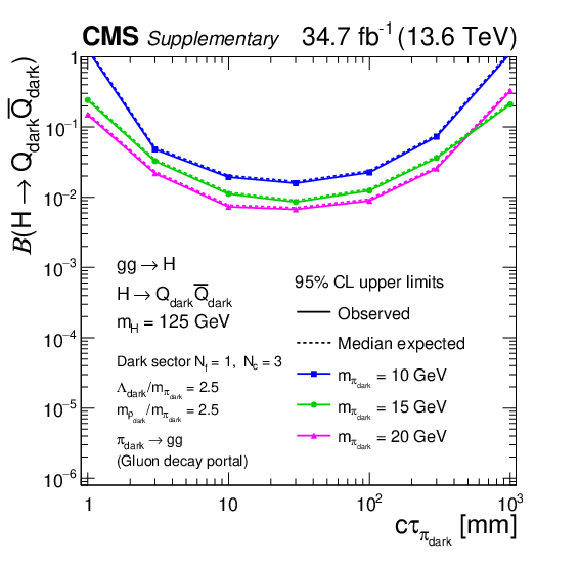
png pdf |
Additional Figure 15:
The 95% CL upper limits on the branching fraction for the 125 GeV Higgs boson to decay to a pair of dark quarks $ \mathcal{B}(\mathrm{H}\to\text{Q}_{\text{dark}}\overline{\text{Q}}_{\text{dark}}) $ when the dark sector $ N_{f}= $ 1, $ N_{c}= $ 3. The dark pion $ \pi_{\text{dark}} $ is assumed to decay to a pair of gluons. The upper limits are shown for different dark pion masses $ m_{\pi_{\text{dark}}} $ and proper decay lengths $ c\tau_{\pi_{\text{dark}}} $, with $ m_{\rho_{\text{dark}}}/m_{\pi_{\text{dark}}}= $ 2.5, $ \Lambda_{\text{dark}}/m_{\pi_{\text{dark}}}= $ 1. The dashed (solid) lines represent the expected (observed) upper limits. |
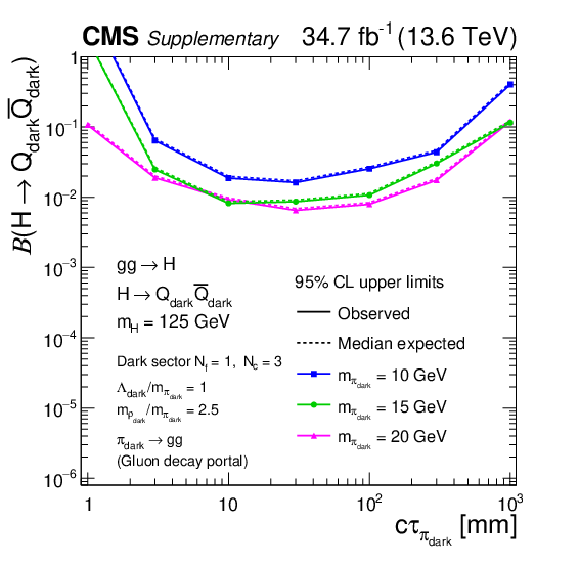
png pdf |
Additional Figure 16:
The 95% CL upper limits on the branching fraction for the 125 GeV Higgs boson to decay to a pair of dark quarks $ \mathcal{B}(\mathrm{H}\to\text{Q}_{\text{dark}}\overline{\text{Q}}_{\text{dark}}) $ when the dark sector $ N_{f}= $ 1, $ N_{c}= $ 3. The dark pion $ \pi_{\text{dark}} $ is assumed to decay to a pair of gluons. The upper limits are shown for different dark pion masses $ m_{\pi_{\text{dark}}} $ and proper decay lengths $ c\tau_{\pi_{\text{dark}}} $, with $ m_{\rho_{\text{dark}}}/m_{\pi_{\text{dark}}}= $ 2.5, $ \Lambda_{\text{dark}}/m_{\pi_{\text{dark}}}= $ 1. The dashed (solid) lines represent the expected (observed) upper limits. |
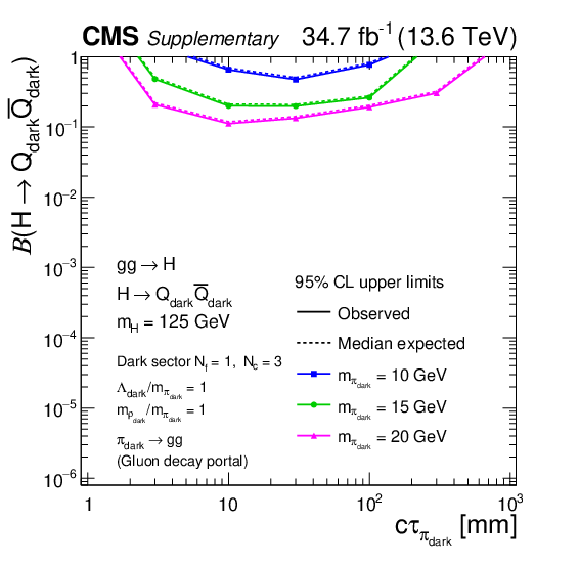
png pdf |
Additional Figure 17:
The 95% CL upper limits on the branching fraction for the 125 GeV Higgs boson to decay to a pair of dark quarks $ \mathcal{B}(\mathrm{H}\to\text{Q}_{\text{dark}}\overline{\text{Q}}_{\text{dark}}) $ when the dark sector $ N_{f}= $ 1, $ N_{c}= $ 3. The dark pion $ \pi_{\text{dark}} $ is assumed to decay to a pair of gluons. The upper limits are shown for different dark pion masses $ m_{\pi_{\text{dark}}} $ and proper decay lengths $ c\tau_{\pi_{\text{dark}}} $, with $ m_{\rho_{\text{dark}}}/m_{\pi_{\text{dark}}}= $ 1, $ \Lambda_{\text{dark}}/m_{\pi_{\text{dark}}}= $ 1. The dashed (solid) lines represent the expected (observed) upper limits. |
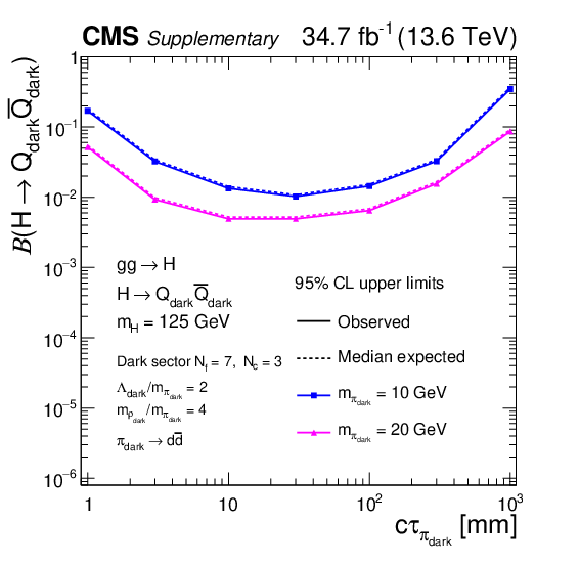
png pdf |
Additional Figure 18:
The 95% CL upper limits on the branching fraction for the 125 GeV Higgs boson to decay to a pair of dark quarks $ \mathcal{B}(\mathrm{H}\to\text{Q}_{\text{dark}}\overline{\text{Q}}_{\text{dark}}) $ when the dark sector $ N_{f}= $ 7, $ N_{c}= $ 3. The dark pions $ \pi_{\text{dark}} $ are assumed to decay to a pair of down quarks. The upper limits are shown for different dark pion masses $ m_{\pi_{\text{dark}}} $ and proper decay lengths $ c\tau_{\pi_{\text{dark}}} $, with $ \Lambda_{\text{dark}}/m_{\pi_{\text{dark}}}= $ 2, $ m_{\rho_{\text{dark}}}/m_{\pi_{\text{dark}}}= $ 4. The dashed (solid) lines represent the expected (observed) upper limits. |
| References | ||||
| 1 | N. Arkani-Hamed and S. Dimopoulos | Supersymmetric unification without low energy supersymmetry and signatures for fine-tuning at the LHC | JHEP 06 (2005) 073 | hep-th/0405159 |
| 2 | G. F. Giudice and A. Romanino | Split supersymmetry | NPB 699 (2004) 65 | hep-ph/0406088 |
| 3 | J. L. Hewett, B. Lillie, M. Masip, and T. G. Rizzo | Signatures of long-lived gluinos in split supersymmetry | JHEP 09 (2004) 070 | hep-ph/0408248 |
| 4 | N. Arkani-Hamed, S. Dimopoulos, G. F. Giudice, and A. Romanino | Aspects of split supersymmetry | NPB 709 (2005) 3 | hep-ph/0409232 |
| 5 | P. Gambino, G. F. Giudice, and P. Slavich | Gluino decays in split supersymmetry | NPB 726 (2005) 35 | hep-ph/0506214 |
| 6 | A. Arvanitaki, N. Craig, S. Dimopoulos, and G. Villadoro | Mini-split | JHEP 02 (2013) 126 | 1210.0555 |
| 7 | N. Arkani-Hamed et al. | Simply unnatural supersymmetry | 1212.6971 | |
| 8 | P. Fayet | Supergauge invariant extension of the Higgs mechanism and a model for the electron and its neutrino | NPB 90 (1975) 104 | |
| 9 | G. R. Farrar and P. Fayet | Phenomenology of the production, decay, and detection of new hadronic states associated with supersymmetry | PLB 76 (1978) 575 | |
| 10 | S. Weinberg | Supersymmetry at ordinary energies. 1. Masses and conservation laws | PRD 26 (1982) 287 | |
| 11 | L. J. Hall and M. Suzuki | Explicit $ R $-parity breaking in supersymmetric models | NPB 231 (1984) 419 | |
| 12 | R. Barbier et al. | $ R $-parity violating supersymmetry | Phys. Rept. 420 (2005) 1 | hep-ph/0406039 |
| 13 | G. F. Giudice and R. Rattazzi | Theories with gauge mediated supersymmetry breaking | Phys. Rept. 322 (1999) 419 | hep-ph/9801271 |
| 14 | P. Meade, N. Seiberg, and D. Shih | General gauge mediation | Prog. Theor. Phys. Suppl. 177 (2009) 143 | 0801.3278 |
| 15 | M. Buican, P. Meade, N. Seiberg, and D. Shih | Exploring general gauge mediation | JHEP 03 (2009) 016 | 0812.3668 |
| 16 | J. Fan, M. Reece, and J. T. Ruderman | Stealth supersymmetry | JHEP 11 (2011) 012 | 1105.5135 |
| 17 | J. Fan, M. Reece, and J. T. Ruderman | A stealth supersymmetry sampler | JHEP 07 (2012) 196 | 1201.4875 |
| 18 | M. J. Strassler and K. M. Zurek | Echoes of a hidden valley at hadron colliders | PLB 651 (2007) 374 | hep-ph/0604261 |
| 19 | M. J. Strassler and K. M. Zurek | Discovering the Higgs through highly-displaced vertices | PLB 661 (2008) 263 | hep-ph/0605193 |
| 20 | T. Han, Z. Si, K. M. Zurek, and M. J. Strassler | Phenomenology of hidden valleys at hadron colliders | JHEP 07 (2008) 008 | 0712.2041 |
| 21 | D. E. Kaplan, M. A. Luty, and K. M. Zurek | Asymmetric dark matter | PRD 79 (2009) 115016 | 0901.4117 |
| 22 | L. J. Hall, K. Jedamzik, J. March-Russell, and S. M. West | Freeze-in production of FIMP dark matter | JHEP 03 (2010) 080 | 0911.1120 |
| 23 | I.-W. Kim and K. M. Zurek | Flavor and collider signatures of asymmetric dark matter | PRD 89 (2014) 035008 | 1310.2617 |
| 24 | R. T. Co, F. D'Eramo, L. J. Hall, and D. Pappadopulo | Freeze-in dark matter with displaced signatures at colliders | JCAP 12 (2015) 024 | 1506.07532 |
| 25 | L. Calibbi, L. Lopez-Honorez, S. Lowette, and A. Mariotti | Singlet-doublet dark matter freeze-in: LHC displaced signatures versus cosmology | JHEP 09 (2018) 037 | 1805.04423 |
| 26 | Z. Chacko, H.-S. Goh, and R. Harnik | The twin Higgs: Natural electroweak breaking from mirror symmetry | PRL 96 (2006) 231802 | hep-ph/0506256 |
| 27 | H. Cai, H.-C. Cheng, and J. Terning | A quirky little Higgs model | JHEP 05 (2009) 045 | 0812.0843 |
| 28 | N. Craig, S. Knapen, and P. Longhi | Neutral naturalness from orbifold Higgs models | PRL 114 (2015) 061803 | 1410.6808 |
| 29 | N. Craig, A. Katz, M. Strassler, and R. Sundrum | Naturalness in the dark at the LHC | JHEP 07 (2015) 105 | 1501.05310 |
| 30 | D. Curtin and C. B. Verhaaren | Discovering uncolored naturalness in exotic Higgs decays | JHEP 12 (2015) 072 | 1506.06141 |
| 31 | C. Csaki, E. Kuflik, S. Lombardo, and O. Slone | Searching for displaced Higgs boson decays | PRD 92 (2015) 073008 | 1508.01522 |
| 32 | S. Alipour-Fard et al. | The second Higgs at the lifetime frontier | JHEP 07 (2020) 029 | 1812.09315 |
| 33 | A. Atre, T. Han, S. Pascoli, and B. Zhang | The search for heavy Majorana neutrinos | JHEP 05 (2009) 030 | 0901.3589 |
| 34 | M. Drewes | The phenomenology of right handed neutrinos | Int. J. Mod. Phys. E 22 (2013) 1330019 | 1303.6912 |
| 35 | F. F. Deppisch, P. S. Bhupal Dev, and A. Pilaftsis | Neutrinos and collider physics | New J. Phys. 17 (2015) 075019 | 1502.06541 |
| 36 | Y. Cai, T. Han, T. Li, and R. Ruiz | Lepton number violation: Seesaw models and their collider tests | Front. Phys. 6 (2018) 40 | 1711.02180 |
| 37 | Y. Cui, L. Randall, and B. Shuve | A WIMPy baryogenesis miracle | JHEP 04 (2012) 075 | 1112.2704 |
| 38 | Y. Cui and R. Sundrum | Baryogenesis for weakly interacting massive particles | PRD 87 (2013) 116013 | 1212.2973 |
| 39 | Y. Cui and B. Shuve | Probing baryogenesis with displaced vertices at the LHC | JHEP 02 (2015) 049 | 1409.6729 |
| 40 | M. Kamionkowski and J. March-Russell | Planck scale physics and the Peccei-Quinn mechanism | PLB 282 (1992) 137 | hep-th/9202003 |
| 41 | A. Hook, S. Kumar, Z. Liu, and R. Sundrum | High quality QCD axion and the LHC | PRL 124 (2020) 221801 | 1911.12364 |
| 42 | CMS Collaboration | The CMS experiment at the CERN LHC | JINST 3 (2008) S08004 | |
| 43 | CMS Collaboration | Development of the CMS detector for the CERN LHC Run 3 | JINST 19 (2024) P05064 | CMS-PRF-21-001 2309.05466 |
| 44 | CMS Collaboration | Search for long-lived particles using displaced jets in proton-proton collisions at $ \sqrt{s} = $ 13 TeV | PRD 104 (2021) 012015 | CMS-EXO-19-021 2012.01581 |
| 45 | CMS Collaboration | Search for long-lived particles produced in association with a Z boson in proton-proton collisions at $ \sqrt{s} $ = 13 TeV | JHEP 03 (2022) 160 | CMS-EXO-20-003 2110.13218 |
| 46 | ATLAS Collaboration | Search for exotic decays of the Higgs boson into long-lived particles in $ pp $ collisions at $ \sqrt{s} $ = 13 TeV using displaced vertices in the ATLAS inner detector | JHEP 11 (2021) 229 | 2107.06092 |
| 47 | ATLAS Collaboration | Search for light long-lived particles in $ pp $ collisions at $ \sqrt{s}= $ 13 TeV using displaced vertices in the ATLAS inner detector | Submitted to Phys. Rev. Lett, 2024 | 2403.15332 |
| 48 | B. Patt and F. Wilczek | Higgs-field portal into hidden sectors | hep-ph/0605188 | |
| 49 | G. Burdman, Z. Chacko, H.-S. Goh, and R. Harnik | Folded supersymmetry and the LEP paradox | JHEP 02 (2007) 009 | hep-ph/0609152 |
| 50 | I. Garcia Garcia, R. Lasenby, and J. March-Russell | Twin Higgs WIMP dark matter | PRD 92 (2015) 055034 | 1505.07109 |
| 51 | N. Craig and A. Katz | The fraternal WIMP miracle | JCAP 10 (2015) 054 | 1505.07113 |
| 52 | D. Curtin et al. | Resurrecting the fraternal twin WIMP miracle | PRD 105 (2022) 035033 | 2106.12578 |
| 53 | M. Farina | Asymmetric twin dark matter | JCAP 11 (2015) 017 | 1506.03520 |
| 54 | M. Farina, A. Monteux, and C. S. Shin | Twin mechanism for baryon and dark matter asymmetries | PRD 94 (2016) 035017 | 1604.08211 |
| 55 | V. Prilepina and Y. Tsai | Reconciling large and small-scale structure in twin Higgs models | JHEP 09 (2017) 033 | 1611.05879 |
| 56 | Y. Hochberg, E. Kuflik, and H. Murayama | Twin Higgs model with strongly interacting massive particle dark matter | PRD 99 (2019) 015005 | 1805.09345 |
| 57 | P. Schwaller | Gravitational waves from a dark phase transition | PRL 115 (2015) 181101 | 1504.07263 |
| 58 | R. Barbieri, L. J. Hall, and K. Harigaya | Minimal mirror twin Higgs | JHEP 11 (2016) 172 | 1609.05589 |
| 59 | K. Fujikura, K. Kamada, Y. Nakai, and M. Yamaguchi | Phase transitions in twin Higgs models | JHEP 12 (2018) 018 | 1810.00574 |
| 60 | O. Matsedonskyi | High-temperature electroweak symmetry breaking by SM twins | JHEP 04 (2021) 036 | 2008.13725 |
| 61 | L. Zu et al. | Mirror QCD phase transition as the origin of the nanohertz stochastic gravitational-wave background | Sci. Bull. 69 (2024) 741 | 2306.16769 |
| 62 | B. Batell and M. McCullough | Neutrino masses from neutral top partners | PRD 92 (2015) 073018 | 1504.04016 |
| 63 | C. Csaki, E. Kuflik, and S. Lombardo | Viable twin cosmology from neutrino mixing | PRD 96 (2017) 055013 | 1703.06884 |
| 64 | S. Bansal et al. | Mirror twin Higgs cosmology: constraints and a possible resolution to the H$ _{0} $ and S$ _{8} $ tensions | JHEP 05 (2022) 050 | 2110.04317 |
| 65 | J. E. Juknevich, D. Melnikov, and M. J. Strassler | A pure-glue hidden valley I. states and decays | JHEP 07 (2009) 055 | 0903.0883 |
| 66 | J. E. Juknevich | Pure-glue hidden valleys through the Higgs portal | JHEP 08 (2010) 121 | 0911.5616 |
| 67 | LHC Higgs Cross Section Working Group | Handbook of LHC Higgs cross sections: 4. Deciphering the nature of the Higgs sector | CERN Report CERN-2017-002-M, 2016 link |
1610.07922 |
| 68 | A. Batz et al. | Dark sector glueballs at the LHC | JHEP 04 (2024) 070 | 2310.13731 |
| 69 | CMS Collaboration | HEPData record for this analysis | link | |
| 70 | The Tracker Group of the CMS Collaboration | The CMS phase-1 pixel detector upgrade | JINST 16 (2021) P02027 | 2012.14304 |
| 71 | CMS Collaboration | Track impact parameter resolution for the full pseudo rapidity coverage in the 2017 dataset with the CMS phase-1 pixel detector | CMS Detector Performance Summary CMS-DP-2020-049, 2020 CDS |
|
| 72 | CMS Collaboration | Performance of the CMS Level-1 trigger in proton-proton collisions at $ \sqrt{s} = $ 13 TeV | JINST 15 (2020) P10017 | CMS-TRG-17-001 2006.10165 |
| 73 | CMS Collaboration | The CMS trigger system | JINST 12 (2017) P01020 | CMS-TRG-12-001 1609.02366 |
| 74 | C. Bierlich et al. | A comprehensive guide to the physics and usage of PYTHIA 8.3 | SciPost Phys. Codeb. 2022 (2022) 8 | 2203.11601 |
| 75 | CMS Collaboration | Extraction and validation of a new set of CMS PYTHIA8 tunes from underlying-event measurements | EPJC 80 (2020) 4 | CMS-GEN-17-001 1903.12179 |
| 76 | P. Nason | A new method for combining NLO QCD with shower Monte Carlo algorithms | JHEP 11 (2004) 040 | hep-ph/0409146 |
| 77 | S. Frixione, P. Nason, and C. Oleari | Matching NLO QCD computations with parton shower simulations: The POWHEG method | JHEP 11 (2007) 070 | 0709.2092 |
| 78 | S. Alioli, P. Nason, C. Oleari, and E. Re | A general framework for implementing NLO calculations in shower Monte Carlo programs: The POWHEG BOX | JHEP 06 (2010) 043 | 1002.2581 |
| 79 | E. Bagnaschi, G. Degrassi, P. Slavich, and A. Vicini | Higgs production via gluon fusion in the POWHEG approach in the SM and in the MSSM | JHEP 02 (2012) 088 | 1111.2854 |
| 80 | A. Karlberg et al. | Ad interim recommendations for the Higgs boson production cross sections at $ \sqrt{s} = $ 13.6 TeV | 2402.09955 | |
| 81 | NNPDF Collaboration | Parton distributions from high-precision collider data | EPJC 77 (2017) 663 | 1706.00428 |
| 82 | GEANT4 Collaboration | GEANT 4---a simulation toolkit | NIM A 506 (2003) 250 | |
| 83 | M. Cacciari, G. P. Salam, and G. Soyez | The anti-$ k_{\mathrm{T}} $ jet clustering algorithm | JHEP 04 (2008) 063 | 0802.1189 |
| 84 | M. Cacciari, G. P. Salam, and G. Soyez | FastJet user manual | EPJC 72 (2012) 1896 | 1111.6097 |
| 85 | CMS Collaboration | Technical proposal for the Phase-II upgrade of the Compact Muon Solenoid | CMS Technical Proposal CERN-LHCC-2015-010, CMS-TDR-15-02, 2015 CDS |
|
| 86 | CMS Collaboration | Performance of long lived particle triggers in Run 3 | CMS Detector Performance Summary CMS-DP-2023-043, 2023 CDS |
|
| 87 | CMS Collaboration | Description and performance of track and primary-vertex reconstruction with the CMS tracker | JINST 9 (2014) P10009 | CMS-TRK-11-001 1405.6569 |
| 88 | W. Waltenberger | Adaptive vertex reconstruction | CMS Note CMS-NOTE-2008-033, 2008 | |
| 89 | A. Strandlie and R. Frühwirth | Track and vertex reconstruction: From classical to adaptive methods | Rev. Mod. Phys. 82 (2010) 1419 | |
| 90 | R. Frühwirth, W. Waltenberger, and P. Vanlaer | Adaptive vertex fitting | JPG 34 (2007) N343 | |
| 91 | P. Battaglia et al. | Interaction networks for learning about objects, relations and physics | in Proc. \it 30th Int. Conf. on Neural Information Processing Systems\/, NIPS'16, . Curran Associates Inc., Red Hook, NY, USA, 2016 | 1612.00222 |
| 92 | J. Gilmer et al. | Neural message passing for quantum chemistry | in Proc. 34th Int. Conf. on Machine Learning, D. Precup and Y.W. Teh, eds., PMLR, 2017 link |
1704.01212 |
| 93 | S. Hochreiter and J. Schmidhuber | Long short-term memory | Neural Comput. 9 (1997) 1735 | |
| 94 | M. Abadi et al. | TensorFlow: A system for large-scale machine learning | in Proc. 12th USENIX Conf. on Operating Systems Design and Implementation, OSDI'16, USENIX Association, USA, 2016 | 1605.08695 |
| 95 | I. J. Good | Rational decisions | J. R. Stat. Soc. 14 (1952) 107 | |
| 96 | G. Punzi | Sensitivity of searches for new signals and its optimization | in Proc. PHYSTAT 2023 Statistical Problems in Particle Physics, Astrophysics and Cosmology, 2023 link |
physics/0308063 |
| 97 | S. Choi and H. Oh | Improved extrapolation methods of data-driven background estimations in high energy physics | EPJC 81 (2021) 643 | 1906.10831 |
| 98 | L. Demortier | P values and nuisance parameters | in Statistical issues for LHC physics. Proceedings, Workshop, PHYSTAT-LHC, Geneva, Switzerland, 2007 link |
|
| 99 | CMS Collaboration | Luminosity measurement in proton-proton collisions at 13.6 TeV in 2022 at CMS | CMS Physics Analysis Summary, 2024 CMS-PAS-LUM-22-001 |
CMS-PAS-LUM-22-001 |
| 100 | CMS Collaboration | Measurement of the inelastic proton-proton cross section at $ \sqrt{s}= $ 13 TeV | JHEP 07 (2018) 161 | CMS-FSQ-15-005 1802.02613 |
| 101 | T. Junk | Confidence level computation for combining searches with small statistics | NIM A 434 (1999) 435 | hep-ex/9902006 |
| 102 | A. L. Read | Presentation of search results: The $ \text{CL}_\text{s} $ technique | JPG 28 (2002) 2693 | |
| 103 | ATLAS and CMS Collaborations, The LHC Higgs Combination group | Procedure for the LHC Higgs boson search combination in Summer 2011 | Technical Report CMS-NOTE-2011-005, ATL-PHYS-PUB-2011-11, 2011 | |
| 104 | G. Cowan, K. Cranmer, E. Gross, and O. Vitells | Asymptotic formulae for likelihood-based tests of new physics | EPJC 71 (2011) 1554 | 1007.1727 |
| 105 | CMS Collaboration | The CMS statistical analysis and combination tool: Combine | Accepted for publication by Comput. Softw. Big Sci, 2024 | CMS-CAT-23-001 2404.06614 |
| 106 | CMS Collaboration | Enriching the physics program of the CMS experiment via data scouting and data parking | Accepted for publication by Phys. Rept, 2024 | CMS-EXO-23-007 2403.16134 |
| 107 | M. J. Strassler | Why Unparticle Models with Mass Gaps are Examples of Hidden Valleys | 0801.0629 | |
| 108 | P. Schwaller, D. Stolarski, and A. Weiler | Emerging Jets | JHEP 05 (2015) 059 | 1502.05409 |
| 109 | S. Knapen, J. Shelton, and D. Xu | Perturbative benchmark models for a dark shower search program | PRD 103 (2021) 115013 | 2103.01238 |

|
Compact Muon Solenoid LHC, CERN |

|

|

|

|

|

|